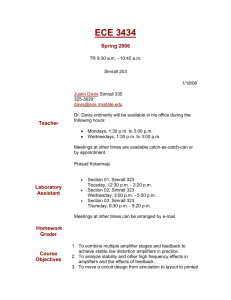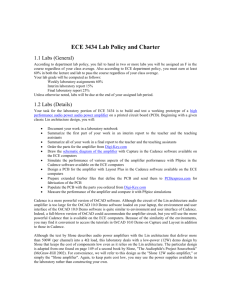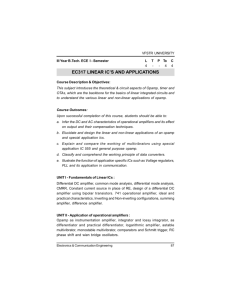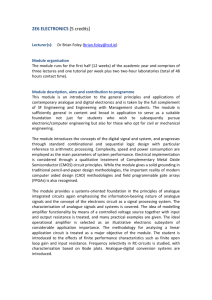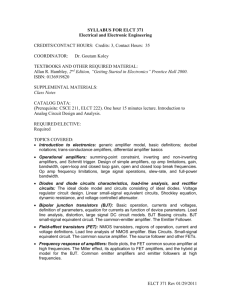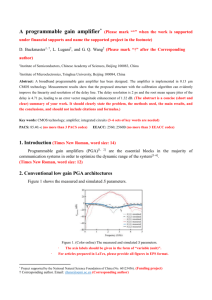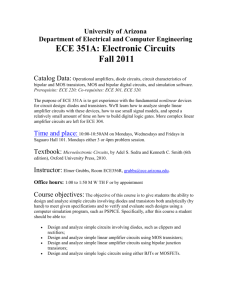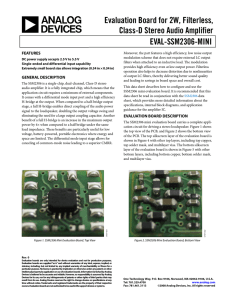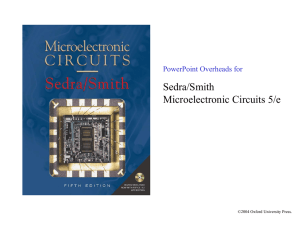EE 4743/6743
advertisement
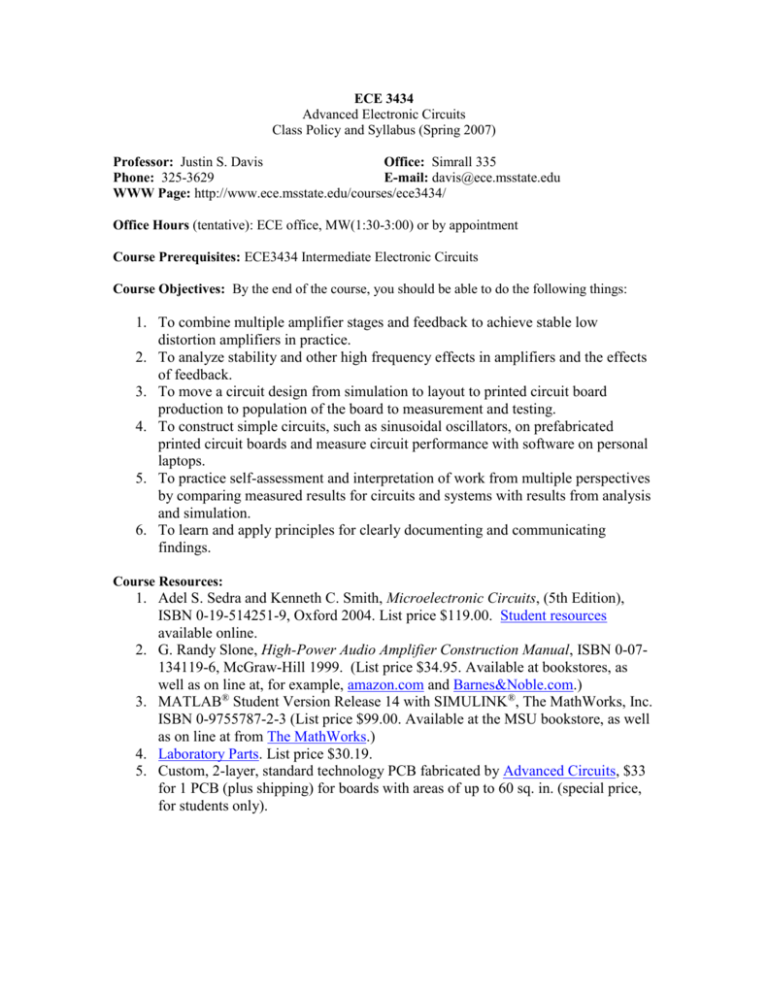
ECE 3434 Advanced Electronic Circuits Class Policy and Syllabus (Spring 2007) Professor: Justin S. Davis Office: Simrall 335 Phone: 325-3629 E-mail: davis@ece.msstate.edu WWW Page: http://www.ece.msstate.edu/courses/ece3434/ Office Hours (tentative): ECE office, MW(1:30-3:00) or by appointment Course Prerequisites: ECE3434 Intermediate Electronic Circuits Course Objectives: By the end of the course, you should be able to do the following things: 1. To combine multiple amplifier stages and feedback to achieve stable low distortion amplifiers in practice. 2. To analyze stability and other high frequency effects in amplifiers and the effects of feedback. 3. To move a circuit design from simulation to layout to printed circuit board production to population of the board to measurement and testing. 4. To construct simple circuits, such as sinusoidal oscillators, on prefabricated printed circuit boards and measure circuit performance with software on personal laptops. 5. To practice self-assessment and interpretation of work from multiple perspectives by comparing measured results for circuits and systems with results from analysis and simulation. 6. To learn and apply principles for clearly documenting and communicating findings. Course Resources: 1. Adel S. Sedra and Kenneth C. Smith, Microelectronic Circuits, (5th Edition), ISBN 0-19-514251-9, Oxford 2004. List price $119.00. Student resources available online. 2. G. Randy Slone, High-Power Audio Amplifier Construction Manual, ISBN 0-07134119-6, McGraw-Hill 1999. (List price $34.95. Available at bookstores, as well as on line at, for example, amazon.com and Barnes&Noble.com.) 3. MATLAB® Student Version Release 14 with SIMULINK®, The MathWorks, Inc. ISBN 0-9755787-2-3 (List price $99.00. Available at the MSU bookstore, as well as on line at from The MathWorks.) 4. Laboratory Parts. List price $30.19. 5. Custom, 2-layer, standard technology PCB fabricated by Advanced Circuits, $33 for 1 PCB (plus shipping) for boards with areas of up to 60 sq. in. (special price, for students only). Grade Determination: Tests Final Labs Homework 45% 20% 25% 10% ---100% Total: Letter grades will be given as follows: A 100-90 B 89-80 C 79-70 D 69-60 F 59-0 Final letter grades are assigned based on the class distribution. Student grades-to-date will be emailed periodically. It is your responsibility to verify that your grades have been correctly entered. In addition to the percentage distributions above, you must achieve at least a 60% grade average on ALL in-class material (exams + final) and a 60% grade average on all out of class material (labs+homework) in order to get a ‘D’ in the course. This prevents you from simply ignoring either the in-class material or out-of-class material in favor of the other. Test Schedule (tentative): Test #1 Test #2 Test #3 Test #4 Test #5 Test #6 Test #7 Jan 17 (W) Jan 31 (W) Feb 14 (W) Feb 28 (W) Mar 21 (W) Apr 4 (W) Apr 18 (W) Final May 2 @ 12am Your lowest test grade will be dropped. Your test average will be computed from the six highest test grades. There will be no make-up tests. Test re-grade policy: If you think there has been an error in grading your exam, you may request one re-grade for each exam. The request must be in writing and contain your entire argument justifying the change. Submit your exam and your statement either to me personally, or put it under my door, or put it in my mailbox. However, I cannot guarantee that I will receive the submission unless it is given to me personally. (You may submit it under the wrong door or mailbox, for example) It must be submitted within one week of the date the exams are returned. I will consider each case and return my response in writing along with your exam. Once I have given my response, I will not discuss the matter further. Make sure you say everything you want to in your first submission. Homework: ● ● ● ● ● You will receive zero credit for writing down the correct answer. To receive credit, you must document clearly what principles you used to solve each problem and the steps you followed. One of the objectives of this course is to develop your skills in writing technical reports. A key to success in writing technical reports is documenting and explaining your work to other professionals. You must clearly document and explain your work to the grader to receive credit for each homework assignment. Homework is due at the beginning of the class period on the date specified in the Schedule. Late homework will not be accepted after the beginning of the class meeting on the date specified in the Schedule. You will receive no more than 75% credit for late homework. Your homework grade will be determined by your best n-2 (out of n) grades on the homework assignments. You are encouraged to develop and share ideas for solutions of homework assignments with others in the class but the work you submit cannot closely duplicate that submitted by another student. The work you submit must demonstrate clearly to the grader your personal, individual effort. For example, neither words of explanation, graphics (including screen shots), nor the format of MATLAB® commands should duplicate those in the work of another student. Even though you work cooperatively with others, you must demonstrate to the grader that you did not merely replicate the work of someone else. Excessively similar submissions will earn a grade of zero. In addition, a report of academic misconduct will be filed according to the Policies and Procedures for Handling Academic Misconduct. Lab: ● ● ● ● According to the laboratory schedule, each student will build and test a working prototype of a high performance audio power amplifier on a printed circuit board (PCB). Before or during each scheduled laboratory session, each student will complete the specified tasks, will record the results into the laboratory notebook, and submit the work to the teaching assistant for evaluation. For Laboratory 8 (after completion PCB design), each student will write and submit an interim laboratory report before the end of the scheduled time for that laboratory session. The main purpose of the report is to describe to the teacher and the teaching assistants the progress and problems, as well as well as their resolution, in accomplishing the task of building the working prototype. The report will also describe the basic operation and function of the various subcircuits of the given amplifier design. For Laboratory 12, each student will write and submit a final laboratory before the end of the scheduled time for that laboratory session. The final report will expand the interim report to include work on laboratories 9, 10, and 11, and will incorporate improvements in content and style that arise from evaluation of the ● ● interim report. The report also will compare the Lin architecture of the audio amplifier with that of a 741 operational amplifier Sedra/Smith pp. 893 - 898) and the LM380 IC power amplifier (Sedra/Smith pp. 1261 - 1264). A student who fails to complete and submit a notebook for review, or a report before the end of the laboratory session at which it is due will receive no more than 90% credit for that work when it is submitted later. The laboratory grade will be calculated as follows: 40%: Weekly laboratory notebook evaluations. 15%: Interim laboratory report. 20%: Final laboratory report. 5%: Milestone 1, successful Cadence PSpice simulation of the frequency response of the given design. 5%: Milestone 2, receive PCB from Advanced Circuits. 5%: Milestone 3, fully populate the PCB with components from the parts list. 10%: Milestone 4, demonstrate operation of the Slone 12W amplifier with third harmonic distortion of 1% or less at 1kHz . 10%: Bonus Milestone: demonstrate operation of the Slone 12W amplifier with THD distortion of 0.01% or less at 1kHz . Attendance: Students are expected to be present for all tests and for the final exam. In extreme cases, I may arrange a make-up test. I will not be taking regular attendance, but I strongly suggest coming to class as the tests are based off material discussed in class. It is the student's responsibility to contact me IN ADVANCE to explain the situation and arrange a makeup. Academic Dishonesty: You may DISCUSS work, and verbally answer questions about lab work from other students. You may NOT SHOW your work to another student, or provide an 'old copy' as an example. Looking at or copying any material (schematics, VHDL files, simulation files, etc.) from another student is considered academic dishonesty. The person providing this material would also be guilty of academic dishonesty. If I find a student guilty of academic dishonesty, expect an F in the course and an academic dishonesty claim to go into your permanent academic record. For graduate students, an F in any course results in immediate expulsion.
